Investigation of the Pulmonary Artery Hypertension Using an Ad Hoc OpenFOAM CFD Solver
Abstract
1. Introduction
2. Mathematical and Numerical Method
2.1. Geometries of Pulmonary Artery and Generation of the Computational Domain
2.2. Model Setup
3. Results
3.1. Convergence-Grid Sensibility Study and Preliminary Discussion
3.2. Comparison Between Healthy and Diseased Pulmonary Arteries
4. Conclusions
- The pressure is highest upstream in the central artery, which, being broader, maintains higher pressure levels. Conversely, in the smaller branches, the increase in resistance causes a reduction in pressure as the blood flows through.
- The presence of PAH increases the average pressure in the pulmonary artery of the investigated subjects from 14 mmHg (sane subject) to 50 mmHg (diseased subject). The pressure field becomes more uniform with a range of variation of approximately 100 Pa, while for a healthy subject it is ≈1600 Pa.
- In healthy individuals, we observed a more turbulent, swirling flow along the walls of the arteries. Flow velocity is averagely equal to 1 m/s; on the opposite, in the presence of hypertension, due to increased vascular resistance, velocity magnitude falls to values of approximately 0.1 m/s, and the flow becomes more uniform with a lower turbulence intensity.
- Pulmonary hypertension induces dramatic changes in the WSS of the pulmonary vasculature. Wall shear stresses are more homogeneous and four times lower in patients with PAH compared with healthy subjects. These outcomes have significant effects on pulmonary endothelial health and vasculature remodeling.
Author Contributions
Funding
Institutional Review Board Statement
Informed Consent Statement
Data Availability Statement
Acknowledgments
Conflicts of Interest
Abbreviations
| CFD | Computational Fluid Dynamic |
| DES | Detached Eddy Simulation |
| MRI | Magnetic Resonance Imaging |
| MRA | Magnetic Resonance Angiography |
| PC-MRI | Phase Contrast Magnetic Resonance Imaging |
| PISO | Pressure Implicit with splitting of operator |
| LES | Large Eddy Simulation |
| RAS | Reynolds-Averaged Navier–Stokes |
| WK | Wind Kessel |
| MPA | Main Pulmonary Artery |
| RPA | Right Pulmonary Artery |
| LPA | Left Pulmonary Artery |
| WSS | Wall Shear Stress |
References
- Silverthorn, D.U. Human Physiology; Jones & Bartlett Publishers: Burlington, MA, USA, 2015. [Google Scholar]
- Garamendi, P.M.; Lucena, J.S.; Gómez-Bueno, M.; Segovia, J. Pulmonary Artery Pathology; Springer: Cham, Switzerland, 2015; pp. 31–52. [Google Scholar] [CrossRef]
- Tang, Q.H.; Chen, J.; Hu, C.F.; Zhang, X.L. Comparison Between Endovascular and Open Surgery for the Treatment of Peripheral Artery Diseases: A Meta-Analysis. Ann. Vasc. Surg. 2020, 62, 484–495. [Google Scholar] [CrossRef]
- Man, J.H.; Rodriguez, C.N.; Sharafuddin, M.J. The Use of Preoperative Imaging for Planning Endovascular and Hybrid Procedures. In Vascular Reconstructions: Anatomy, Exposures and Techniques; Springer: New York, NY, USA, 2021; pp. 433–442. [Google Scholar] [CrossRef]
- de Zélicourt, D.A.; Steele, B.N.; Yoganathan, A.P. Advances in Computational Simulations for Interventional Treatments and Surgical Planning. In Image-Based Computational Modeling of the Human Circulatory and Pulmonary Systems: Methods and Applications; Springer: Boston, MA, USA, 2010; pp. 343–373. [Google Scholar] [CrossRef]
- Dedè, L.; Menghini, F.; Quarteroni, A. Computational fluid dynamics of blood flow in an idealized left human heart. Int. J. Numer. Methods Biomed. Eng. 2021, 37, e3287. [Google Scholar] [CrossRef]
- Lee, B.K. Computational Fluid Dynamics in Cardiovascular Disease. Korean Circ. J. 2011, 41, 423–430. [Google Scholar] [CrossRef] [PubMed]
- Kheyfets, V.O.; O’Dell, W.; Smith, T.; Reilly, J.J.; Finol, E.A. Considerations for Numerical Modeling of the Pulmonary Circulation—A Review With a Focus on Pulmonary Hypertension. J. Biomech. Eng. 2013, 135, 061011. [Google Scholar] [CrossRef] [PubMed]
- Basri, E.I.; Riazuddin, V.N.; Azriff, A.; Zuber, M.; Ahmad, K.; Shahwir, S. Computational Fluid Dynamics Study in Biomedical Applications: A Review. Int. J. Fluids Heat Transf. 2016, 1, 2–14. [Google Scholar]
- Ana Fernández Tena, P.C.C. Use of Computational Fluid Dynamics in Respiratory Medicine. Arch. Bronconeumol. 2015, 51, 293–298. [Google Scholar] [CrossRef]
- DeCampli, W.M.; Argueta-Morales, I.R.; Divo, E.; Kassab, A.J. Computational fluid dynamics in congenital heart disease. Cardiol. Young 2012, 22, 800–808. [Google Scholar] [CrossRef]
- Löhner, R.; Cebral, J.; Soto, O.; Yim, P.; Burgess, J.E. Applications of patient-specific CFD in medicine and life sciences. Int. J. Numer. Methods Fluids 2003, 43, 637–650. [Google Scholar] [CrossRef]
- Xu, P.; Liu, X.; Zhang, H.; Ghista, D.; Zhang, D.; Shi, C.; Huang, W. Assessment of boundary conditions for CFD simulation in human carotid artery. Biomech. Model. Mechanobiol. 2018, 17, 1581–1597. [Google Scholar] [CrossRef] [PubMed]
- Pirola, S.; Cheng, Z.; Jarral, O.; O’Regan, D.; Pepper, J.; Athanasiou, T.; Xu, X. On the choice of outlet boundary conditions for patient-specific analysis of aortic flow using computational fluid dynamics. J. Biomech. 2017, 60, 15–21. [Google Scholar] [CrossRef]
- Madhavan, S.; Kemmerling, E.M.C. The effect of inlet and outlet boundary conditions in image-based CFD modeling of aortic flow. Biomed. Eng. Online 2018, 17, 66. [Google Scholar] [CrossRef]
- Hardman, D.; Semple, S.I.; Richards, J.M.; Hoskins, P.R. Comparison of patient-specific inlet boundary conditions in the numerical modelling of blood flow in abdominal aortic aneurysm disease. Int. J. Numer. Methods Biomed. Eng. 2013, 29, 165–178. [Google Scholar] [CrossRef]
- Antonuccio, M.N.; Mariotti, A.; Fanni, B.M.; Capellini, K.; Capelli, C.; Sauvage, E.; Celi, S. Effects of uncertainty of outlet boundary conditions in a patient-specific case of aortic coarctation. Ann. Biomed. Eng. 2021, 49, 3494–3507. [Google Scholar] [CrossRef] [PubMed]
- Boumpouli, M.; Danton, M.H.; Gourlay, T.; Kazakidi, A. Blood flow simulations in the pulmonary bifurcation in relation to adult patients with repaired tetralogy of Fallot. Med. Eng. Phys. 2020, 85, 123–138. [Google Scholar] [CrossRef] [PubMed]
- Catanho, M.; Sinha, M.; Vijayan, V. Model of Aortic Blood Flow Using the Windkessel Effect; University of California of San Diago: San Diago, CA, USA, 2012. [Google Scholar]
- Westerhof, N.; Lankhaar, J.W.; Westerhof, B.E. The arterial windkessel. Med. Biol. Eng. Comput. 2009, 47, 131–141. [Google Scholar] [CrossRef]
- Wilson, N.M.; Ortiz, A.K.; Johnson, A.B. The vascular model repository: A public resource of medical imaging data and blood flow simulation results. J. Med. Devices 2013, 7, 040923. [Google Scholar] [CrossRef] [PubMed]
- Tang, B.T.; Fonte, T.A.; Chan, F.P.; Tsao, P.S.; Feinstein, J.A.; Taylor, C.A. Three-Dimensional Hemodynamics in the Human Pulmonary Arteries Under Resting and Exercise Conditions. Ann. Biomed. Eng. 2011, 39, 347–358. [Google Scholar] [CrossRef] [PubMed]
- Zambrano, B.A.; McLean, N.; Zhao, X.; Tan, J.L.; Zhong, L.; Figueroa, C.A.; Lee, L.C.; Baek, S. Patient-Specific Computational Analysis of Hemodynamics and Wall Mechanics and Their Interactions in Pulmonary Arterial Hypertension. Front. Bioeng. Biotechnol. 2020, 8, 611149. [Google Scholar] [CrossRef] [PubMed]
- Duronio, F.; Mascio, A.D. Blood Flow Simulation of Aneurysmatic and Sane Thoracic Aorta Using OpenFOAM CFD Software. Fluids 2023, 8, 272. [Google Scholar] [CrossRef]
- Duronio, F.; Di Mascio, A.; De Vita, A.; Innocenzi, V.; Prisciandaro, M. Eulerian–Lagrangian modeling of phase transition for application to cavitation-driven chemical processes. Phys. Fluids 2023, 35, 053305. [Google Scholar] [CrossRef]
- Dutta, H. Mathematical Methods in Engineering and Applied Sciences; CRC Press: Boca Raton, FL, USA, 2020. [Google Scholar]
- De Vita, M.; Duronio, F.; De Vita, A.; De Berardinis, P. Adaptive Retrofit for Adaptive Reuse: Converting an Industrial Chimney into a Ventilation Duct to Improve Internal Comfort in a Historic Environment. Sustainability 2022, 14, 3360. [Google Scholar] [CrossRef]
- Lee Waite, P.; Fine, J. Applied Biofluid Mechanics; The McGraw-Hill Medical Companies, Inc.: New York, NY, USA, 2007. [Google Scholar]
- Conijn, M.; Krings, G.J. Computational Analysis of the Pulmonary Arteries in Congenital Heart Disease: A Review of the Methods and Results. Comput. Math. Methods Med. 2021, 2021, 2618625. [Google Scholar] [CrossRef] [PubMed]
- Spalart, P.R.; Deck, S.; Shur, M.L.; Squires, K.D.; Strelets, M.K.; Travin, A. A new version of detached-eddy simulation, resistant to ambiguous grid densities. Theor. Comput. Fluid Dyn. 2006, 20, 181–195. [Google Scholar] [CrossRef]
- Lungu, A.; Wild, J.; Capener, D.; Kiely, D.; Swift, A.; Hose, D. MRI model-based non-invasive differential diagnosis in pulmonary hypertension. J. Biomech. 2014, 47, 2941–2947. [Google Scholar] [CrossRef] [PubMed]
- Kozitza, C.J.; Colebank, M.J.; Gonzalez-Pereira, J.P.; Chesler, N.C.; Lamers, L.; Roldán-Alzate, A.; Witzenburg, C.M. Estimating pulmonary arterial remodeling via an animal-specific computational model of pulmonary artery stenosis. Biomech. Model. Mechanobiol. 2024, 23, 1469–1490. [Google Scholar] [CrossRef] [PubMed]
- Capuano, F.; Loke, Y.H.; Balaras, E. Blood Flow Dynamics at the Pulmonary Artery Bifurcation. Fluids 2019, 4, 190. [Google Scholar] [CrossRef]
- Roache, P.J. Quantification of uncertainty in computational fluid dynamics. Annu. Rev. Fluid Mech. 1997, 29, 123–160. [Google Scholar] [CrossRef]
- Duronio, F.; Di Mascio, A. Implementation and assessment of a low-dissipative OpenFOAM solver for compressible multi-species flows. Comput. Fluids 2024, 274, 106240. [Google Scholar] [CrossRef]
- Roache, P.J. Fundamentals of Computational Fluid Dynamics; Hermosa Publishers: Socorro, Mexico, 1998. [Google Scholar]
- Di Mascio, A.; Dubbioso, G.; Muscari, R. Vortex structures in the wake of a marine propeller operating close to a free surface. J. Fluid Mech. 2022, 949, A33. [Google Scholar] [CrossRef]
- Pope, S.B. Turbulent flows. Meas. Sci. Technol. 2001, 12, 2020–2021. [Google Scholar] [CrossRef]
- Odagiri, K.; Inui, N.; Hakamata, A.; Inoue, Y.; Suda, T.; Takehara, Y.; Sakahara, H.; Sugiyama, M.; Alley, M.T.; Wakayama, T.; et al. Non-invasive evaluation of pulmonary arterial blood flow and wall shear stress in pulmonary arterial hypertension with 3D phase contrast magnetic resonance imaging. Springerplus 2016, 5, 1071. [Google Scholar] [CrossRef] [PubMed]
- Tang, B.T.; Pickard, S.S.; Chan, F.P.; Tsao, P.S.; Taylor, C.A.; Feinstein, J.A. Wall Shear Stress is Decreased in the Pulmonary Arteries of Patients with Pulmonary Arterial Hypertension: An Image-Based, Computational Fluid Dynamics Study. Pulm. Circ. 2012, 2, 470–476. [Google Scholar] [CrossRef] [PubMed]
- Sanz, J.; Kuschnir, P.; Rius, T.; Salguero, R.; Sulica, R.; Einstein, A.J.; Dellegrottaglie, S.; Fuster, V.; Rajagopalan, S.; Poon, M. Pulmonary arterial hypertension: Noninvasive detection with phase-contrast MR imaging. Radiology 2007, 243, 70–79. [Google Scholar] [CrossRef]
- Morgan, V.L.; Roselli, R.J.; Lorenz, C.H. Normal three-dimensional pulmonary artery flow determined by phase contrast magnetic resonance imaging. Ann. Biomed. Eng. 1998, 26, 557–566. [Google Scholar] [CrossRef] [PubMed]
- Parent, R.A. Comparative Biology of the Normal Lung; Academic Press: Cambridge, MA, USA, 2015. [Google Scholar]
- Reiter, U.; Reiter, G.; Kovacs, G.; Stalder, A.F.; Gulsun, M.A.; Greiser, A.; Olschewski, H.; Fuchsjäger, M. Evaluation of elevated mean pulmonary arterial pressure based on magnetic resonance 4D velocity mapping: Comparison of visualization techniques. PLoS ONE 2013, 8, e82212. [Google Scholar] [CrossRef] [PubMed]
- Laaban, J.P.; Diebold, B.; Zelinski, R.; Lafay, M.; Raffoul, H.; Rochemaure, J. Noninvasive Estimation of Systolic Pulmonary Artery Pressure Using Doppler Echocardiography in Patients with Chronic Obstructive Pulmonary Disease. Chest 1989, 96, 1258–1262. [Google Scholar] [CrossRef] [PubMed]
- Pillalamarri, N.R.; Piskin, S.; Patnaik, S.S.; Murali, S.; Finol, E.A. Patient-Specific Computational Analysis of Hemodynamics in Adult Pulmonary Hypertension. Ann. Biomed. Eng. 2021, 49, 3465–3480. [Google Scholar] [CrossRef] [PubMed]

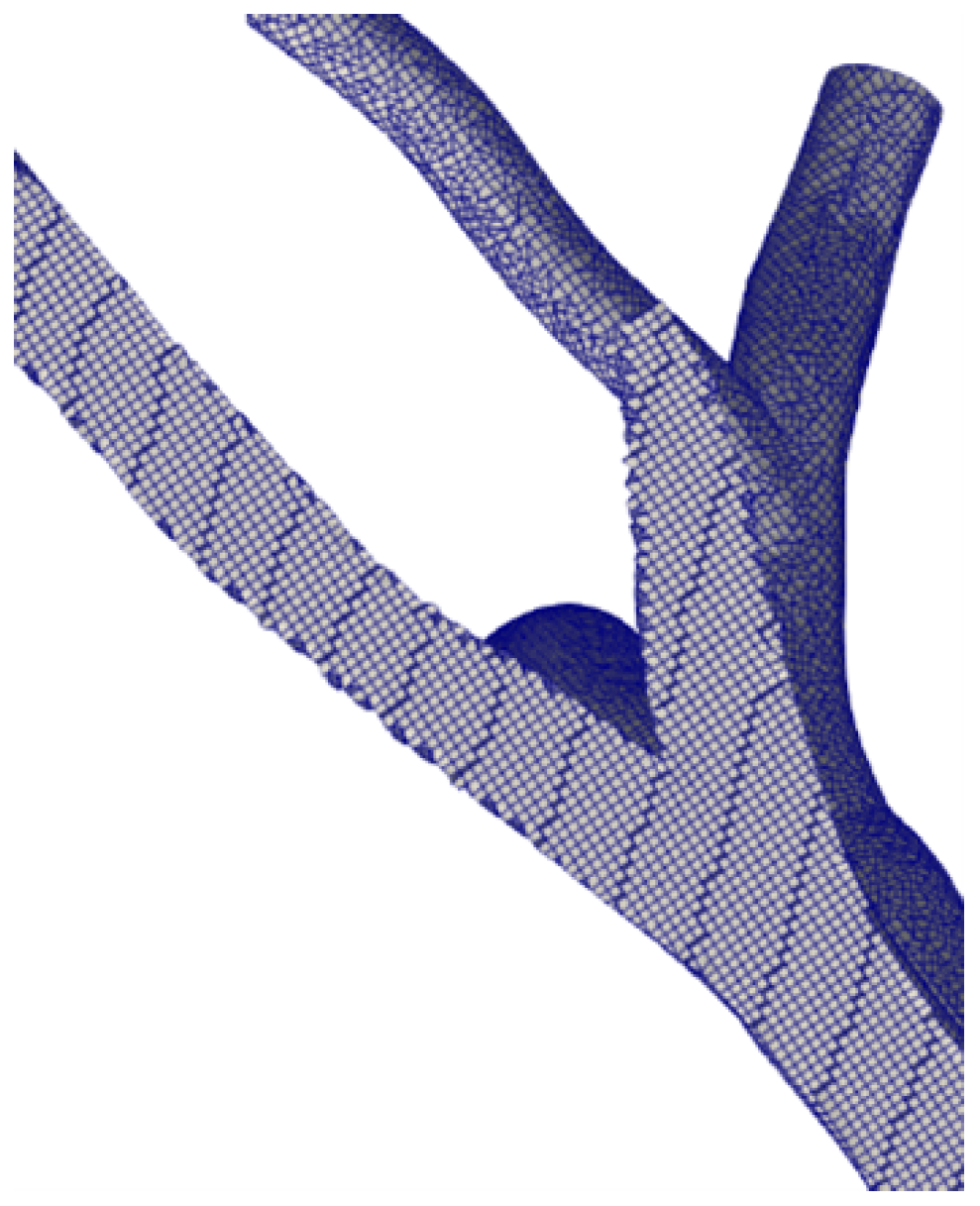
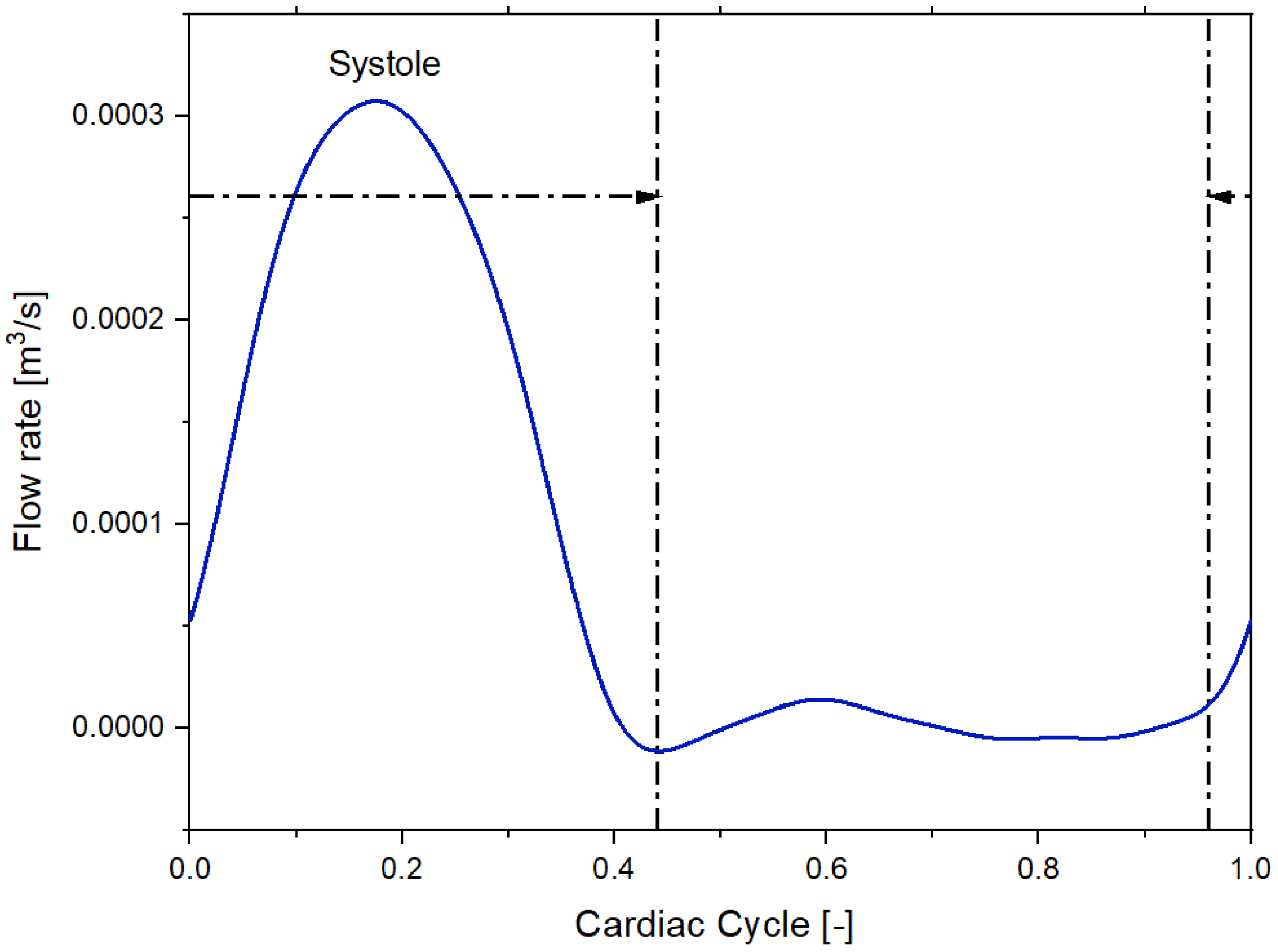
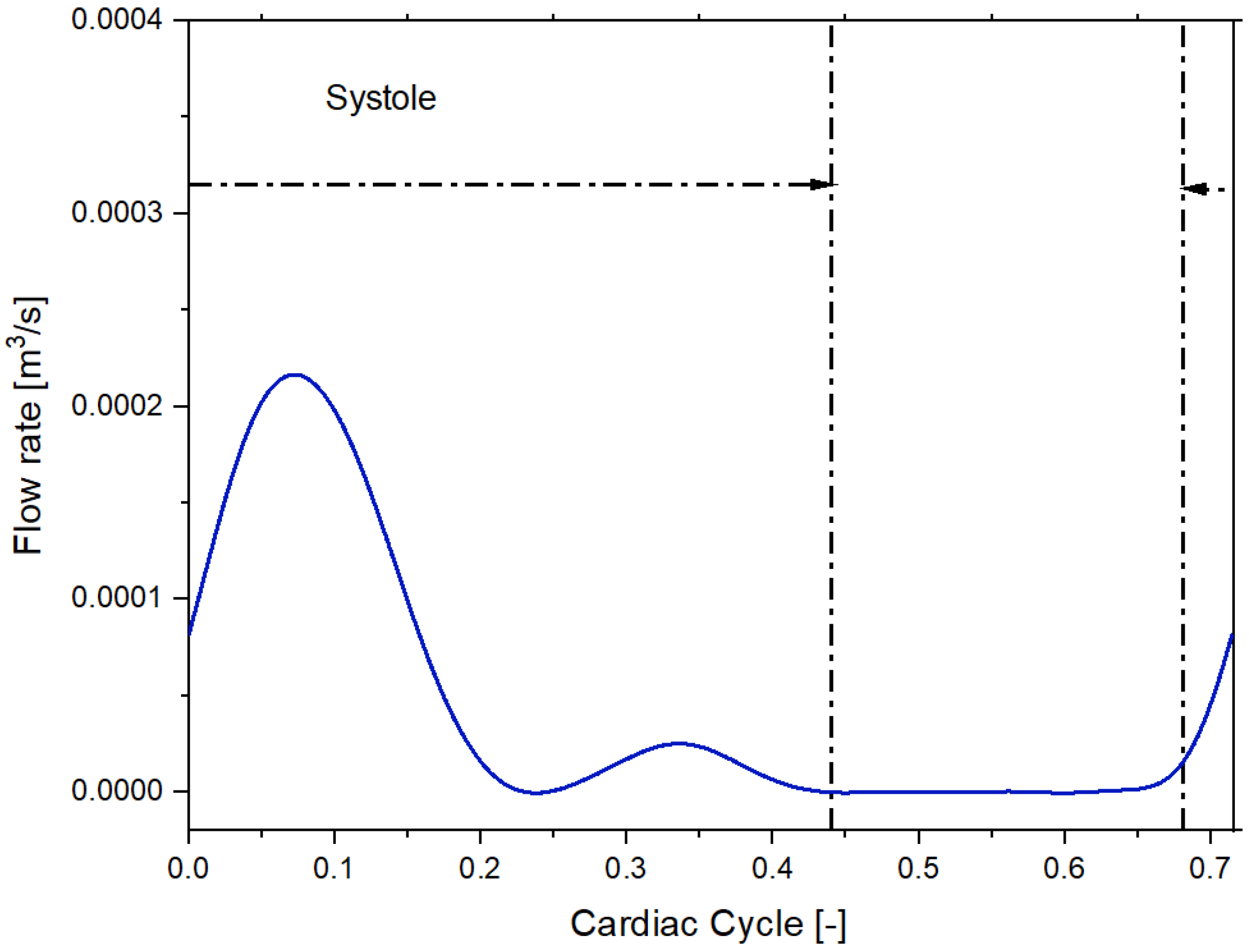

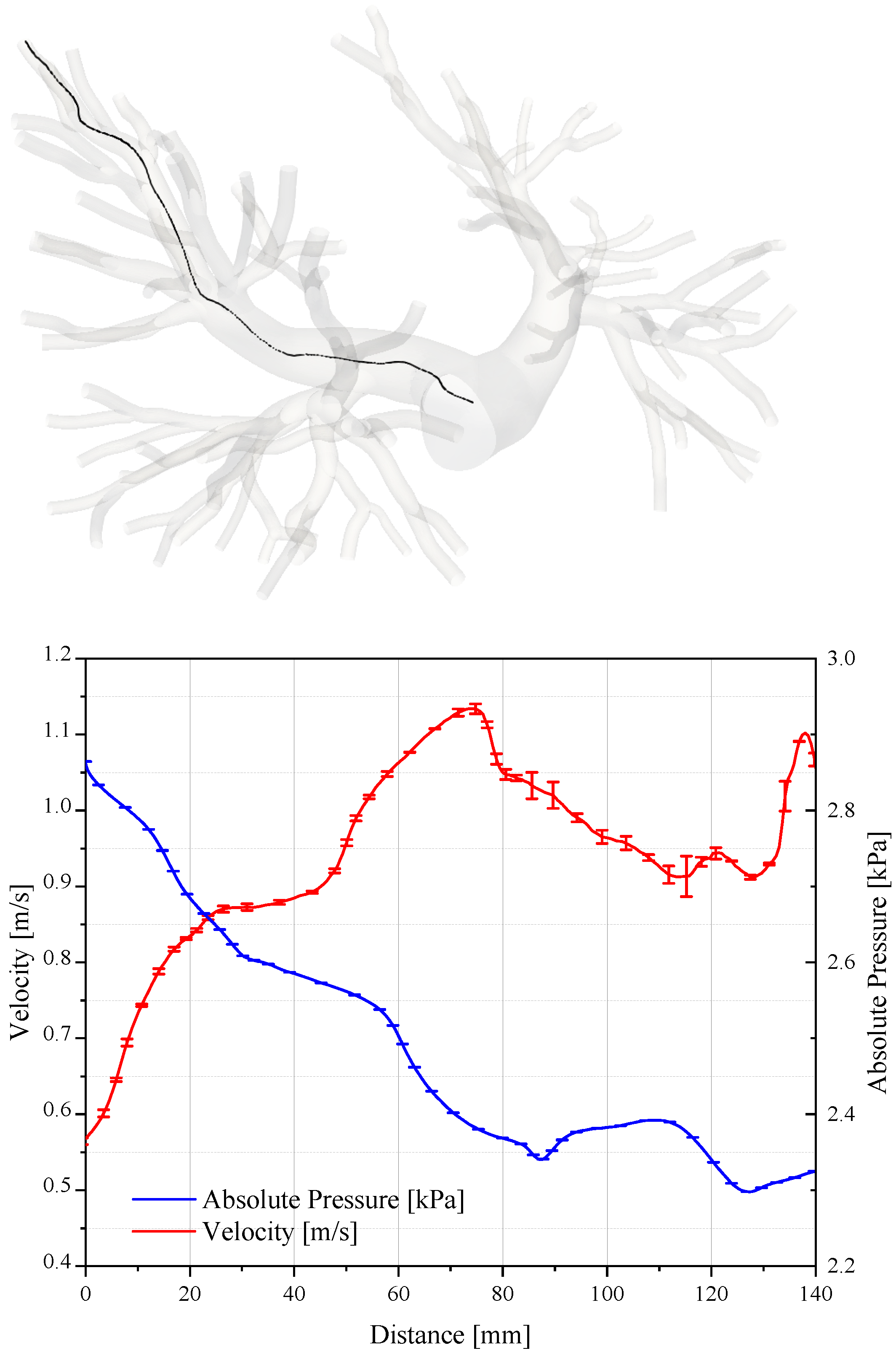
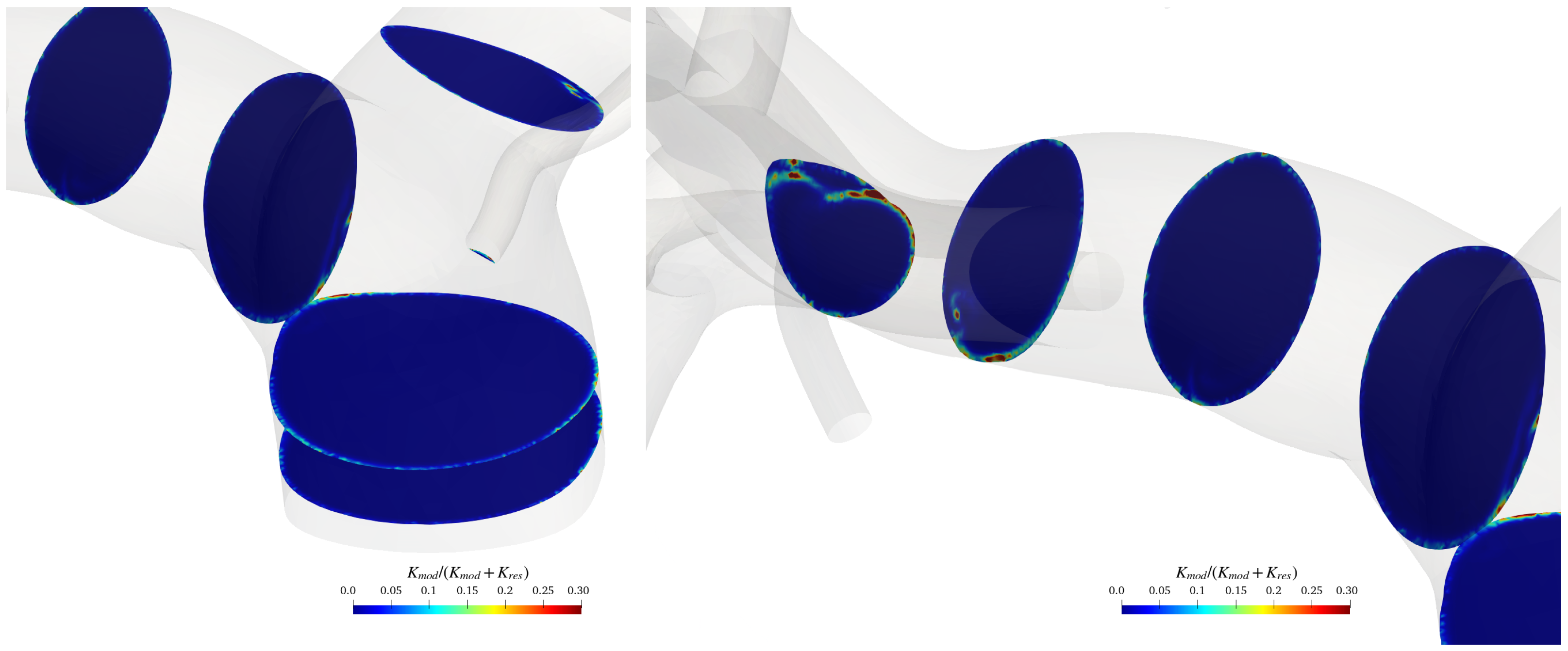
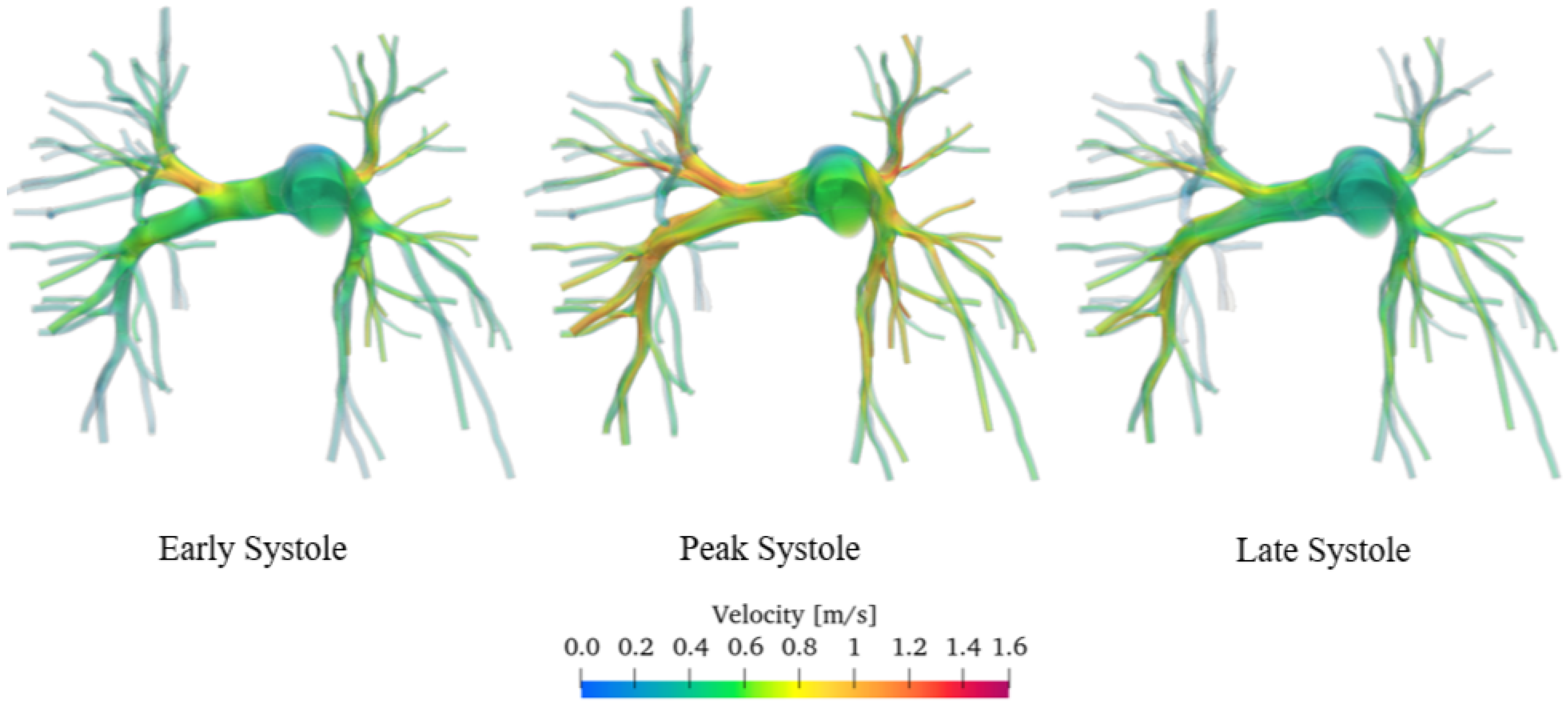

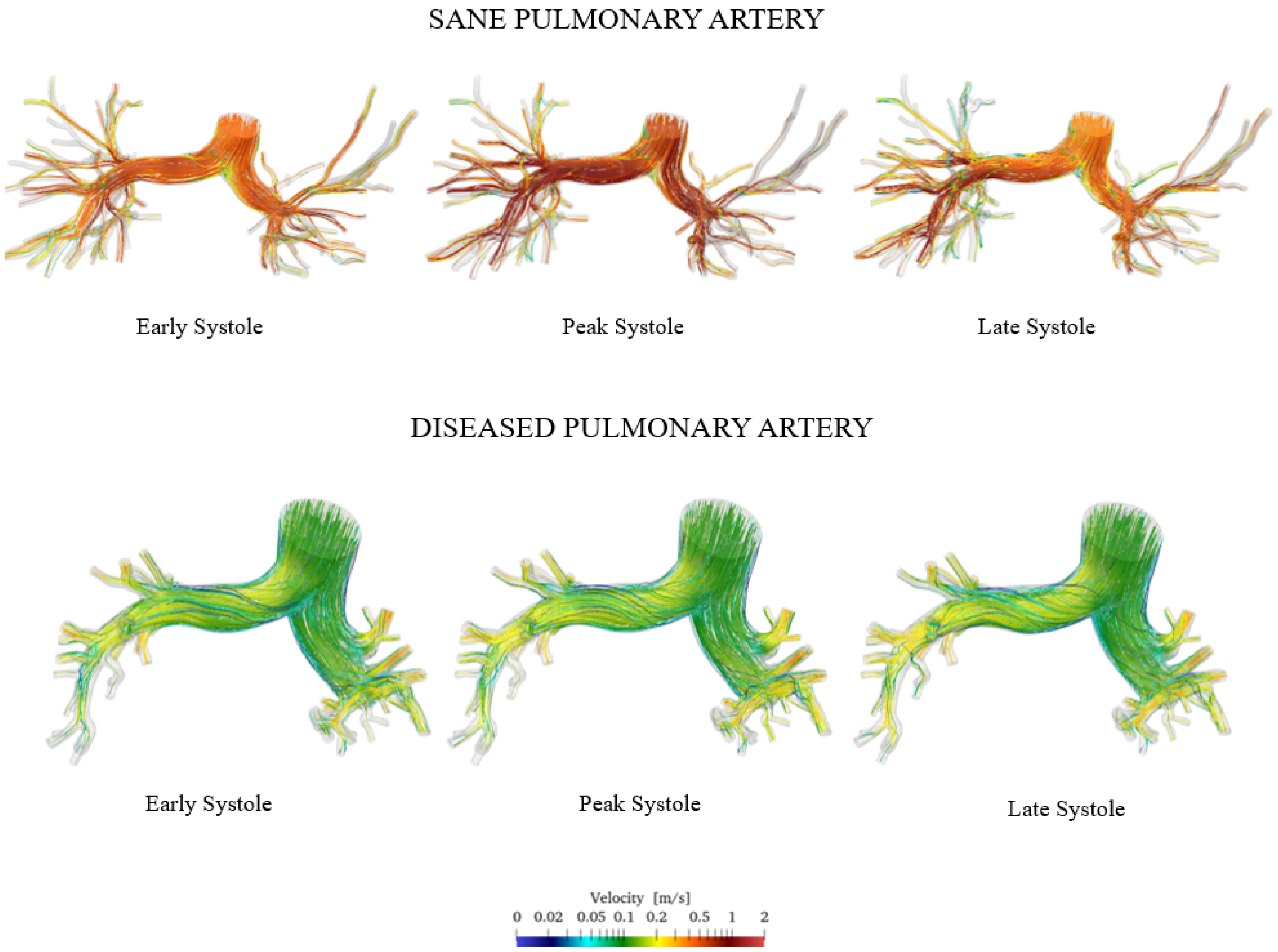
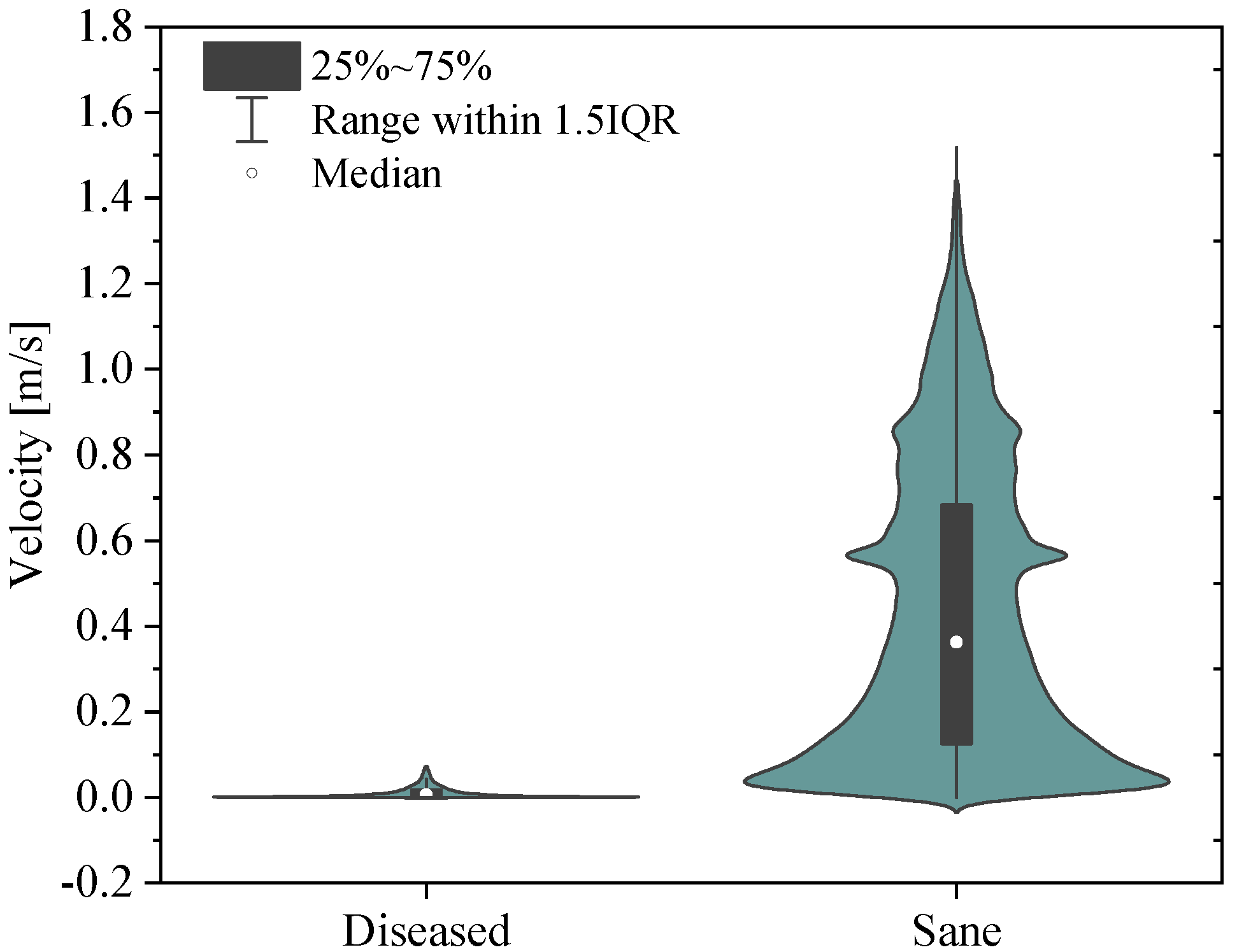
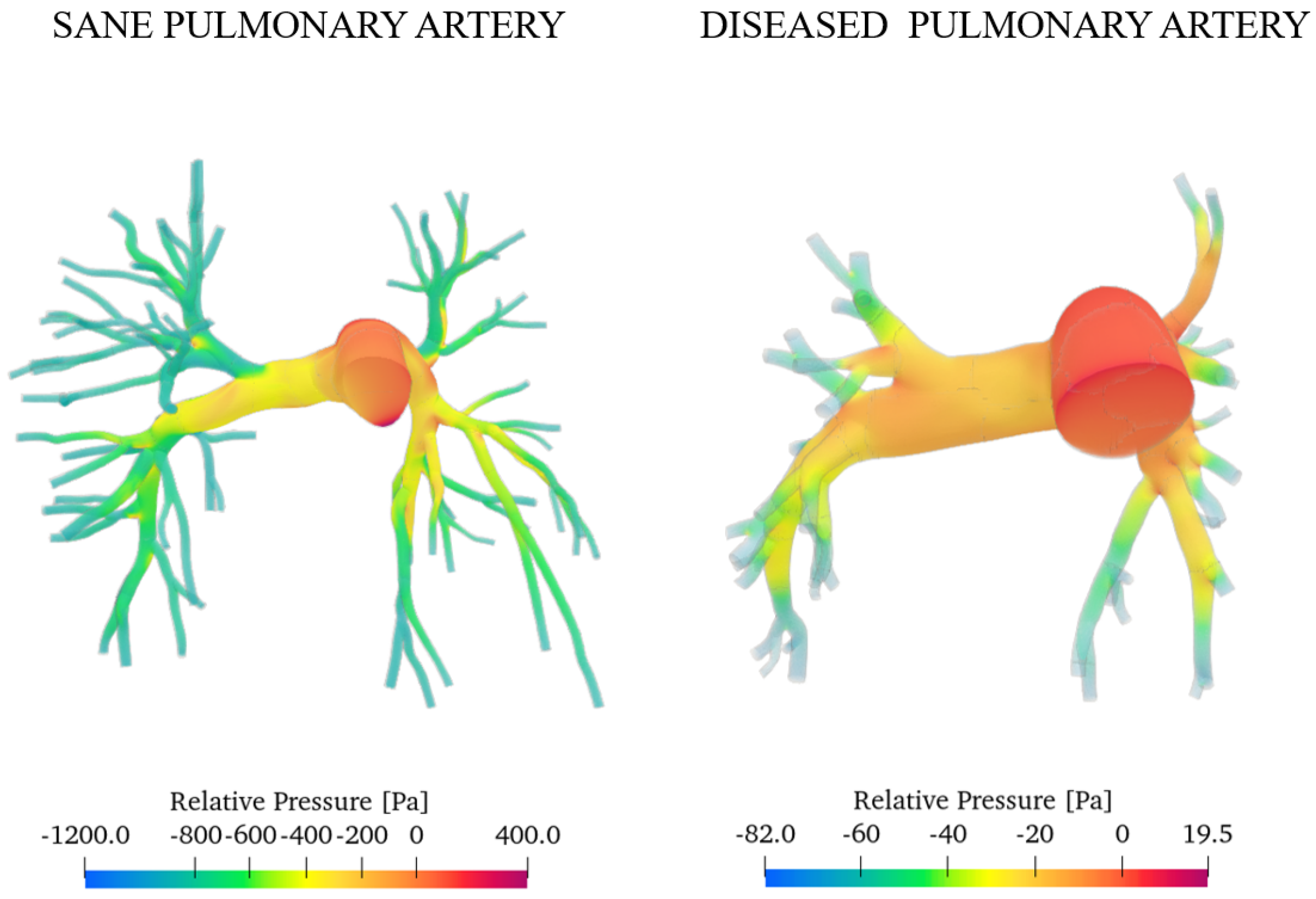
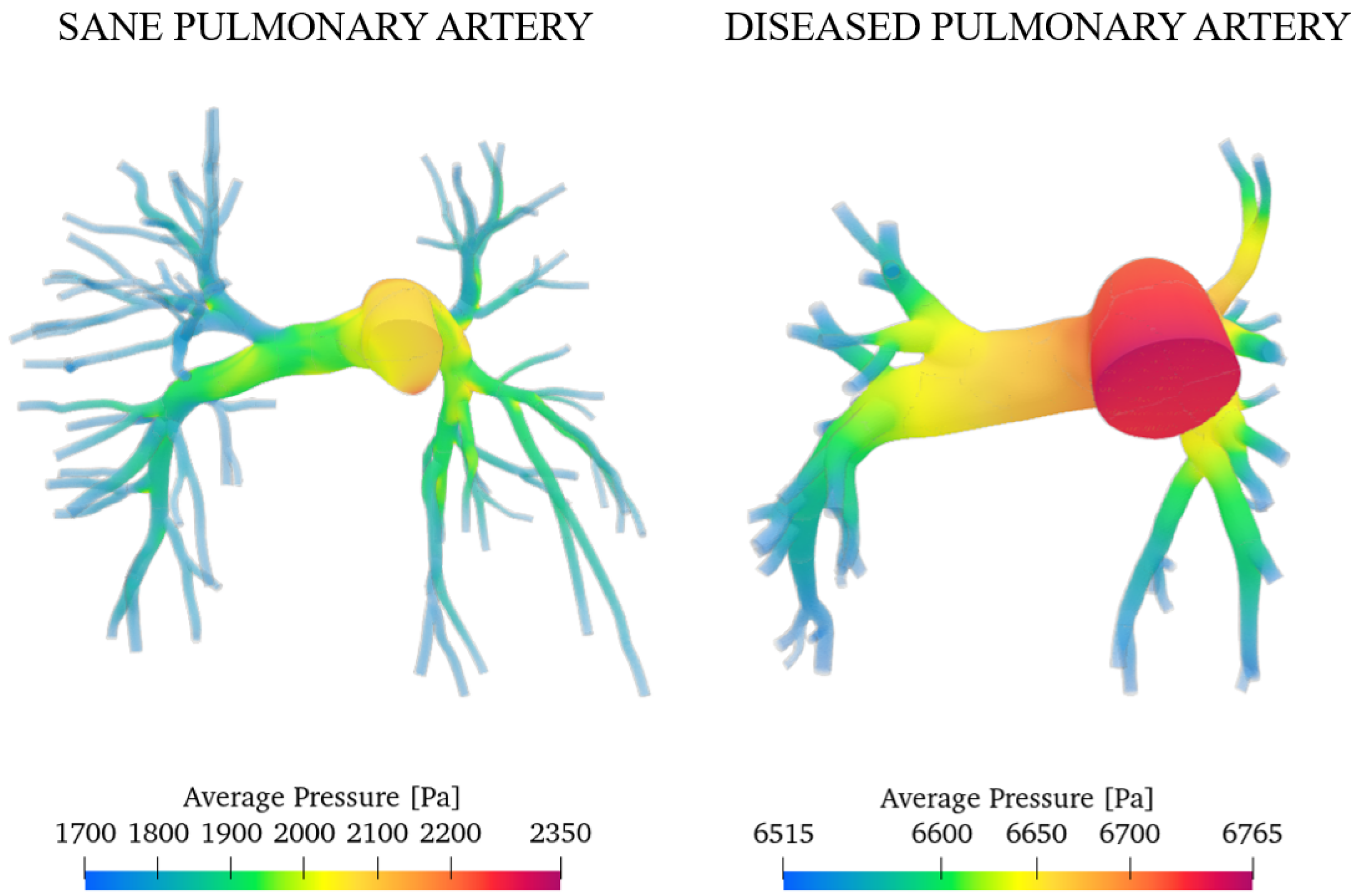
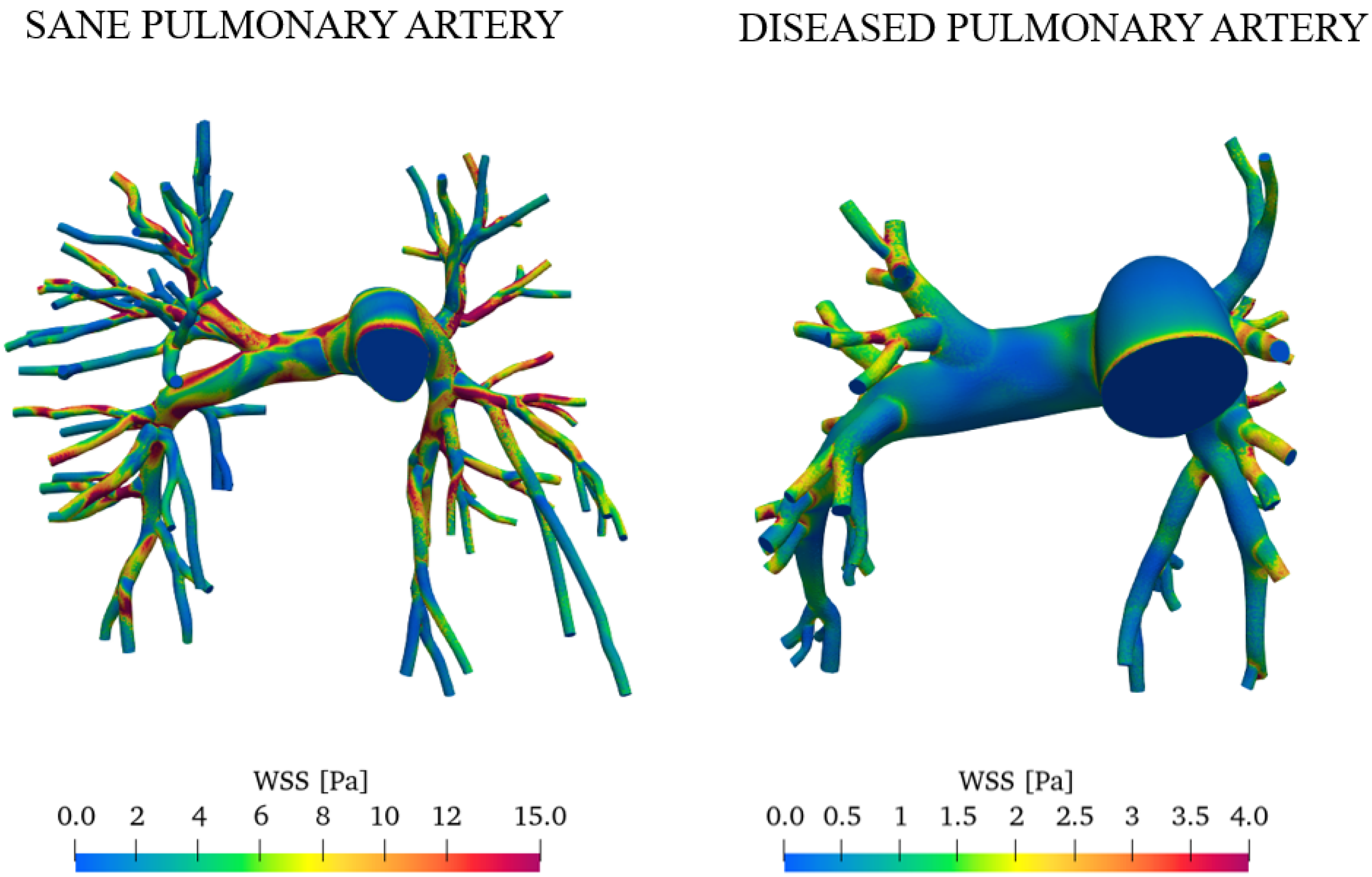
| C | |||
|---|---|---|---|
| Sane | |||
| Diseased |
| Grid Convergence Index | Order of Convergence | |
|---|---|---|
| U | 1.32% | 1.87 |
| p | 1.09% | 1.20 |
Disclaimer/Publisher’s Note: The statements, opinions and data contained in all publications are solely those of the individual author(s) and contributor(s) and not of MDPI and/or the editor(s). MDPI and/or the editor(s) disclaim responsibility for any injury to people or property resulting from any ideas, methods, instructions or products referred to in the content. |
© 2024 by the authors. Licensee MDPI, Basel, Switzerland. This article is an open access article distributed under the terms and conditions of the Creative Commons Attribution (CC BY) license (https://creativecommons.org/licenses/by/4.0/).
Share and Cite
Duronio, F.; Marchetti, P. Investigation of the Pulmonary Artery Hypertension Using an Ad Hoc OpenFOAM CFD Solver. Fluids 2025, 10, 6. https://doi.org/10.3390/fluids10010006
Duronio F, Marchetti P. Investigation of the Pulmonary Artery Hypertension Using an Ad Hoc OpenFOAM CFD Solver. Fluids. 2025; 10(1):6. https://doi.org/10.3390/fluids10010006
Chicago/Turabian StyleDuronio, Francesco, and Paola Marchetti. 2025. "Investigation of the Pulmonary Artery Hypertension Using an Ad Hoc OpenFOAM CFD Solver" Fluids 10, no. 1: 6. https://doi.org/10.3390/fluids10010006
APA StyleDuronio, F., & Marchetti, P. (2025). Investigation of the Pulmonary Artery Hypertension Using an Ad Hoc OpenFOAM CFD Solver. Fluids, 10(1), 6. https://doi.org/10.3390/fluids10010006







